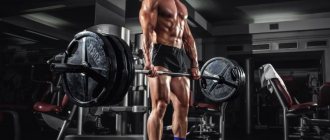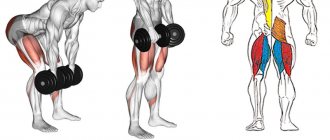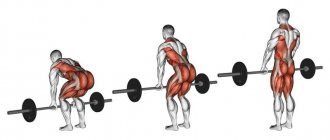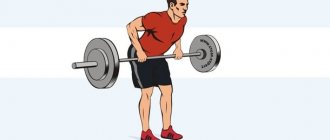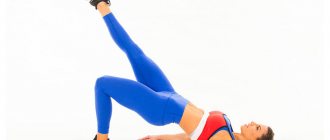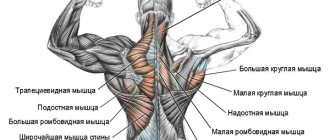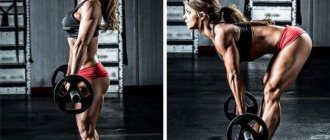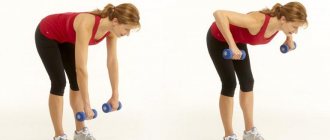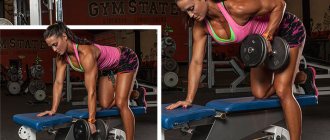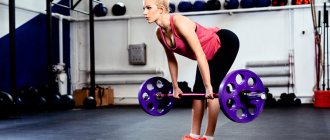Muscle classification
Any physical exercise, including deadlift, must be performed according to certain rules, and, first of all, it is necessary to follow the technique - then the body will receive maximum benefit. Otherwise, the exercise will not only be useless, but also dangerous.
The load mainly affects the following muscle sections:
Gluteal region and leg area:
- Large gluteals.
- Quadriceps.
- Hamstring biceps.
- Calf muscle complex.
- Soleus muscles.
- Small leg muscle sections.
- Skeletal.
Lumbar and abdominal area:
- Extensor part of the back.
- Lower abdominal muscles.
- Oblique muscle sections of the outer abdomen.
Main body:
- Latissimus dorsi muscles.
- Large rounded.
- Trapezoidal.
- Diamond-shaped.
But these groups are not the only ones involved in deadlifting. The arm muscles will definitely work, as they are forced to lift and hold the weight.
You don't have to worry about your hands becoming ugly and rough - they just get a little load and a slight stretch, thanks to which the muscles in this part become stronger.
What is “she”, racks and stuff
This basic exercise is very popular among representatives of strength sports due to the fact that, roughly speaking, it involves almost the entire body. Yes, some small muscles do not take part in the movement, but 95% of the muscles of the body, one way or another, contribute to the exercise. Some act as stabilizer muscles (responsible for balance), while others directly affect weight lifting.
By the way, deadlifts for girls are an excellent tool for correcting their own figure: butt, all planes of the legs, back and abdomen.
You can perform deadlifts in several ways; more precisely, use several stances (leg positions) when performing. The most widespread is the so-called classic stance: feet shoulder-width apart or slightly narrower, toes pointing straight or slightly to the sides, knees do not move apart when sitting down and straightening your legs. If you hear an expression like “pull classically” or “classically”, then be sure that we are talking about the classical position of the legs.
The second stance is called the “sumo” stance. This position of the legs got its name due to the fact that before performing the athlete’s legs are positioned almost as wide as possible. This, on the one hand, is good, because the amplitude of movement is significantly reduced (the distance from the floor to lifting the barbell and straightening the back is reduced by one and a half times). On the other hand, this starting position is not suitable for everyone. But just for fun, try both and choose the one that is most convenient for you.
The barbell grip can be of the same name or different. The difference between them is that in the first case, the hands grasp the barbell in the same way, and in the second, differently (one of the hands with a reverse grip). Again, different grips cause difficulties for beginners.
Interestingly, the deadlift has a variation - the Romanian or dead deadlift. This is already a full-fledged, independent exercise, but the principle of the exercise is very similar. In addition, the deadlift (or stiff-legged row, as it is also called) is often used as an additional exercise after the regular deadlift.
What muscle groups work in different types of exercise?
With different types of exercises, different muscle parts will be involved:
- At the beginning of the deadlift, the gluteal muscles are included in the activity.
- By straightening the body and bending the knees, the quadriceps and hamstrings are trained.
- The posterior thigh muscles are involved in flexion and weight bearing.
- The back muscles are constantly tense, but not extended. Adjacent to them are the trapezius and rhomboid regions, as well as the muscles in the area of flexion of the spinal column. They are able to fix the spine in a standard position, acting as a kind of stabilizer. Due to the work of the rhomboid and trapezius muscles, the back does not bend in the form of an arc, and the entire load falls on the extensor area.
- At the moment of extensor movements of the pelvic region, the muscles of the posterior thigh region - the semitendinosus, semimembranosus, biceps femoris and gluteal region - take part in the deadlift.
- The muscles of the anterior thighs are activated during leg extension and hip flexion. These are the broad muscles - the rectus, intermediate, lateral and medial muscle systems.
Romanian
Knees straight or slightly bent. This leg position produces better results than the classic stance, and lifting weights improves it by making the exercise more focused.
Basically, the posterior thigh area is worked out, while the load on the elongated back muscles is reduced.
This kind of deadlift in bodybuilding is called “dead”; it is included in training sessions for working the hamstrings.
Alexander Shestov
TRX Certified Trainer
Ask a Question
But the Romanian deadlift is not included in heavy lifting and powerlifting exercises, since lifting maximum weight is impossible with straight or bent knees.
Deadlift on straight legs
She is “dead”, she is also “Romanian”. In general, the name is not entirely correct, since it is not correct to do it on completely straight legs. You need to bend your legs a little to protect yourself from unnecessary injuries. The effectiveness of the exercise will only increase. After all, the angle in the hip joint will become sharper, which means the buttocks will work harder. The back should not be lowered below the pelvis. That is, the back should be either parallel to the floor or slightly higher.
This option works well on the buttocks, back and back of the thigh. That is, by doing such a deadlift, you will not weaken your legs, but you will be able to enlarge your buttocks. But there is one minus. The load on the spine here is maximum. This means that you must have a more or less healthy spine and you must do this exercise only with a straight back.
Using a trap neck
This exercise uses a trap bar with a bar in the form of a hexagonal frame, on which holders are located in parallel. This barbell is an ideal device for bodybuilding or fitness.
A trap bar is considered a safer tool than a barbell with a straight bar. Exercises with a trap bar can replace classic squats with a standard instrument on the shoulders, for example, when this is impossible due to injury.
But the “siloviki” do not use this type of barbell, considering it inappropriate. In competitions, weightlifters squat with a straight barbell.
Deadlift while standing on a stand
It's a pull from the pit. It is performed in the same way as the classic version, but the legs are placed on a stand. Thus, the barbell must be pulled and lowered to a lower position. The amplitude increases - the efficiency increases. The height of the stand is 5 – 10 cm. Discs, boards and anything that you can confidently stand on are suitable.
The exercises are difficult to perform and are only suitable for experienced athletes. But it is extremely effective for the buttocks. I would put it in first place in terms of effectiveness for the butt among all pull-downs. But there is one caveat. You need to bend your legs and lower your pelvis quite low (much like in the video). And then you will feel your butt right to the bones.
By the way (applies mainly to girls), if you do deadlifts with small-diameter discs, then you don’t have to stand on a stand, but simply lower the barbell all the way to the floor. The effect is the same. This refers to discs whose diameter is smaller than the standard diameter of 15, 20 and 25 kg discs.
Deadlift with dumbbells
Such exercises are recommended for beginners. You need to stand in a classic pose, lower your arms with dumbbells down. The back is straight and tense. The pelvis is positioned back and raised upward, the body rises. Weights slide over your thighs.
By using dumbbells, you can strengthen the same muscles as with a classic deadlift.
Deadlift Standards
Deadlift standards without equipment.
Federation WPC men
WPC Women Federation
Federation AWPC men
AWPC Women's Federation
Deadlift technique
The basis is the technique of performing exercises according to the classical standard:
- Approximately you need to determine the center of the barbell and place your feet opposite it so that your shins almost touch the metal.
- The feet are straight or slightly turned outward. The feet are either shoulder-width apart or slightly narrower.
- The bar is grasped at a level slightly wider than shoulder width. Hands are an equal distance from both pancakes.
- Squat in front of the barbell without bending your arms at the elbows. The body is flat, a deflection in the lumbar region is acceptable.
- The head is positioned straight, the shoulders are pulled back.
- When the barbell rises, the feet should be pressed firmly to the floor; lifting the heels or toes off the floor is unacceptable.
- The person is in a half-crouched state, while the barbell is being lifted, the back is straight, the barbell is guided along the legs.
- At the end of the workout, the pelvis protrudes slightly forward, and the body is fixed in this position. After a few seconds the weight is lowered.
- Lowering a weight down is carried out in the same way as lifting it, but in the reverse order.
Frequent difficult moments
Lower back pain
Lower back pain may occur when you do not keep your back in a neutral position. If you bend over while performing a deadlift, this can cause damage to the intervertebral discs. How to avoid this?
Keep your chest open and your back neutral, keep the bar as close to your body as possible, use your legs, don't try to deadlift with just your lower back, push rather than pull (think of it as a leg press).
This also applies to lowering the barbell.
Do not throw the projectile with your back bent and your hips straight. Many doctors will prescribe pills to relieve pain, but this is only to treat the symptoms, not the cause. With the help of pain, the body tells you that you are doing something wrong. The best way to get rid of lower back pain is decompression. You won’t find anything better than this on your own—you just need to hang on the horizontal bar for a while.
Hitting the knees with the bar
Hitting your knees with a barbell is quite painful. How to avoid this: You need to lower the bar by moving your hips back. In this case, the legs are bent, the buttocks are moved back. Make sure that your knees are not in the line of movement of the barbell. When the bar reaches your knees, bend your legs to lower the bar.
Bruises and damage to the skin of the legs
When the barbell is too close to your shins, it can scratch them. Unfortunately, this cannot be avoided. The most important thing to pay attention to is the correct technique. What should be done:
- Hold the barbell over the middle of your foot.
- Feet shoulder-width apart to avoid damage to the skin of the shins by the embossing on the bar.
- The feet are spread 15 degrees to the sides.
- Don't try to repeat the squat technique.
- Perform deadlifts on a flat surface so that the bar does not roll toward your shins.
- It is best to wear high socks (any kind will do, as long as they do not restrict movement or create obstacles).
- If you do damage the skin, use an adhesive plaster, stick it in a vertical direction so as not to damage the same place again.
- Improve your technique to avoid this in the future.
Rupture of calluses on hands
It is impossible to avoid the formation of calluses on your hands. And the rupture mainly occurs due to an incorrect grip - when the bar is taken in the middle of the palm. The skin under the barbell folds, causing calluses to form, some sometimes filling with water and tearing. After this, you will have to stop deadlifting for a while. It usually takes 1 week for the callus to heal. But it is quite easy to damage the same place again after a few weeks, since the skin has not fully recovered. The best way to prevent them from happening is to keep the bar very close to your fingers.
This will seem uncomfortable, but over time your palms will get used to it. Use chalk or magnesium on your hands. They will fill the space between the folds of the leather, the leather will not be pinched under the fingerboard because the palms will become smooth.
Precautionary measures
To ensure that deadlift classes go smoothly and without incident, you need to remember the following safety measures:
- Rounding your back while doing deadlifts is unacceptable.
- Sudden movements that can only cause harm are prohibited.
The back should be straight, if the correct weight is chosen, when rounding it, it is necessary to reduce the load.
Young and inexperienced boys and girls should start deadlifting with dumbbells rather than a barbell, since the weight of the dumbbells is small and the center of gravity is distributed equally between the two hands.
Deadlift with bent legs[edit | edit code]
Characteristics
:
- Basic exercise
- Uses multiple joints
- Traction movement
- Closed kinetic chain
- Using weights
- For intermediate and advanced levels
The deadlift is one of the three components of competitive powerlifting, but it is also one of the most versatile and functional exercises in fitness. We offer you a version of this exercise, modified specifically for women.
Equipment
Equipment and shoes for training should be as comfortable as possible. The uniform should be comfortable, not restrict movement, and made from hygroscopic fabric. It is worth choosing your shoes especially carefully. You can purchase special weightlifting weights at a sports store. They have measured flat soles that fit tightly to the foot, which allows the athlete to feel comfortable.
Women should be immediately warned that there should not be any heels, even small ones. Ideally, the sole in the heel area should not be higher than 1 cm. Such shoes should be intended only for training. It is not suitable for every day, since if you wear it constantly, the sole will become deformed, and the position of the feet during lifting weights will become uneven.
